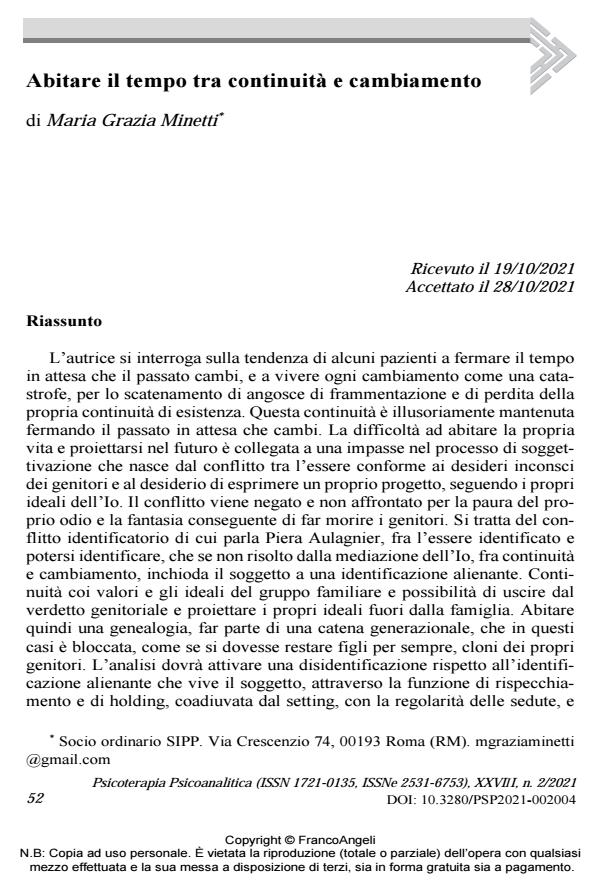Inhabiting time between continuity and change
Journal title PSICOTERAPIA PSICOANALITICA
Author/s Maria Grazia Minetti
Publishing Year 2021 Issue 2021/2
Language Italian Pages 18 P. 52-69 File size 255 KB
DOI 10.3280/PSP2021-002004
DOI is like a bar code for intellectual property: to have more infomation
click here
Below, you can see the article first page
If you want to buy this article in PDF format, you can do it, following the instructions to buy download credits

FrancoAngeli is member of Publishers International Linking Association, Inc (PILA), a not-for-profit association which run the CrossRef service enabling links to and from online scholarly content.
The author questions some patients’ tendency to stop time, while waiting for the change of the past, and to live every change as a catas-trophe due to the triggering of distress of fragmentation and to the loss of their own continuity of existence. Continuity is illusorily maintained by stopping the past and waiting for the past to be changed. The diffi-culty to inhabit their own life and to be projected into the future is connected to an impasse in the process of subjectification that arises from the conflict between being in conformity with the parents’ un-conscious desires and the desire to express one’s own project, follow-ing the ego ‘s own ideals. Conflict is denied and it is not handled by the patients, for fear of their own hatred and the resulting fantasy of their own parents’ death. This is the identifying conflict borrowed from Piera Aulagnier’s theory; it is a conflict between being identified and being able to identify oneself, that holds the subject to an alienating identification. Continuity of family’ s values and ideals; chance to es-cape the family verdict and to project your own values outside the family. That is inhabiting a genealogy, being part of a generational chain, which is blocked in these cases, as if one were to be a child for ever, a clone of her/his own parent. Analysis will need to activate de-identification, with respect to the alienating identification the subject is living, by means of the functions of mirroring and holding, helped by the setting, with regulated sessions, which assumes the role of “the third” allowing the introduction of some space between symmetry and asymmetry, continuity and discontinuity. In particular, the analyst will have to tolerate some moments of bogging down and, occasionally, al-so some real negative therapeutical reactions, especially caused by the difficulty in grieving, since there has not been any loss, it could not have happened and it cannot happen. In these situations there seems to be an irreconcilable dispute sometimes, which blocks the activity of thinking and every psychic work, more than a conflict like that in the statement mors tua vita mea. The analyst will have to work hard for her/his contra-transfer, by questioning her/his wish again with respect to the patient and to her/ his own identity of analyst. While navigating through the different aspects of psychoanalysis, she/ he will be able to deal with the block of her/his thinking, the feeling of powerlessness to which she/he could react with intolerance towards the patient and with excessive furor curandi. After all, it is a question of being able to preserve your analysing capacity; it is a question of staying alive according to Winnicott’s point of view.
Keywords: change of the past, continuity and discontinuity in the pro-cess of subjectification, identification, alienating identification, de-identification, identifying conflict, generational chain.
Maria Grazia Minetti, Abitare il tempo tra continuità e cambiamento in "PSICOTERAPIA PSICOANALITICA" 2/2021, pp 52-69, DOI: 10.3280/PSP2021-002004